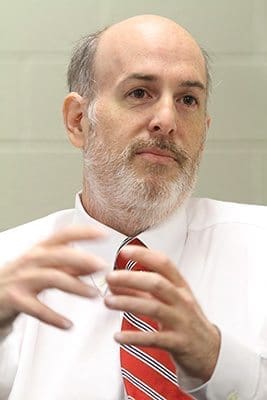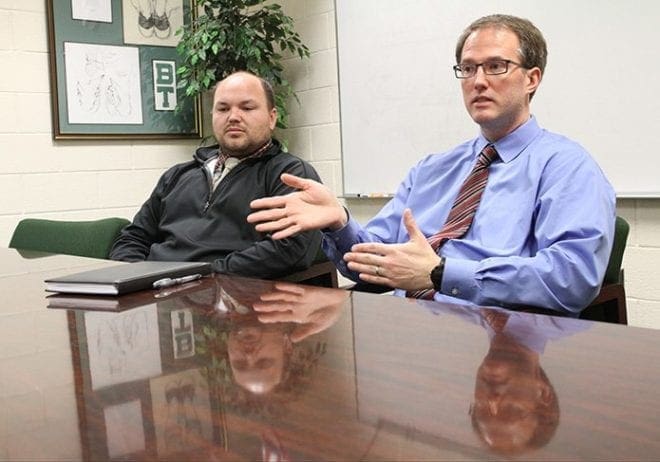 Photo By Michael Alexander
Photo By Michael AlexanderRoswell
No snow day excuses likely after BT succeeds in online classroom try
By ANDREW NELSON, Staff Writer | Published January 22, 2015
ROSWELL—John Wellford’s challenge was how to teach Spanish to students miles from school who checked into his virtual classroom.
The Blessed Trinity High School teacher set aside a lesson on new vocabulary and verb conjugations. Instead, students explored the cultural history of Spain.

Fourth-year Spanish teacher John Wellford said he “had a blast” creating activities and assignments for his students during the virtual school days. Wellford said he also used it as an opportunity to stretch his own limits. Photo By Michael Alexander
They watched a video tour he created using Google Earth, traveling from Madrid to Covadonga to Seville. The students completed quizzes online about prehistoric cave drawings. Wellford shared his own photos of Europe and challenged them to research the landmarks.
“It was a lot of work. It was fun. I had a blast,” said Wellford, who had to learn some new skills to pull off his virtual classroom. Quiz results showed him students explored the country’s history beyond just his assignment. Wellford saw students take the initiative. “They had read more. They had gone off on their own.”
It was part of an online learning experiment in October. Students were sent home for two days and school leaders tested how students and staff would handle online-only assignments.
Digital tools replace improvised system
After last winter, snow days will never be the same at Blessed Trinity. How metro Atlanta handled three inches of snow and ice in 2014 made it the butt of late night humorists. The January winter storm dubbed “Snowpocalypse” paralyzed the region. Hundreds of students, parents and faculty found themselves overnight guests at Catholic schools. Overall, two winter storms in 2014 cancelled six days of school at the Roswell high school.
During those days, some teachers communicated with students as they cobbled together a makeshift system to deliver assignments by email. School staff wanted a better approach after they learned how teachers and students had improvised.
This new system of online learning got its first rollout at Blessed Trinity during two days of testing last fall.
Supporters said blending technology and education helps students develop digital skills they’ll need to succeed in a tech-heavy future. It also stretched teachers to learn tools to educate students who have never known life without the Internet.
Online learning, from AP chemistry to weightlifting
Some 75 teachers at the Roswell school designed curriculum for the October test to mirror classroom learning. Students took quizzes, watched lecture videos and emailed teachers questions. Even subjects without a traditional classroom were taught. Weightlifters learned about exercise nutrition. Students enrolled in a Shakespeare class recorded themselves acting dramatic roles.

Jason Podhorez, right, computer systems administrator for Blessed Trinity High School, and Brent Hollers, part-time robotics teacher and part-time technology integration specialist, provide some details surrounding the technical work that went on behind the scenes to pull off the virtual school days trial last October. Photo By Michael Alexander
For years, technology has often been talked about as revolutionizing classrooms. It seems to have reached that point.
“Now we’re at the point where it really can work,” said principal Frank Moore. “It went way beyond our expectations.”
Educational technology is no longer a fad. Billons of dollars are being spent to create innovative devices. Several Catholic schools in the archdiocese piloted using tablets and Net-Texts digital apps to replace textbooks. Technology has changed how students take online courses, communicate with teachers and work from customized classwork.
It’s no longer the teacher in front of the room, but the teacher collaborating with students to share new and interactive material, said Katherine Quinn-Shea, the director of marketing and client relations at Net-Texts. Some 20,000 students and teachers use the company’s app. It allows educators to deliver tailored curriculum material to student computers.
Digital learning’s strength is it allows teachers to focus on individual academic needs and can be a cost savings for schools instead of buying pricey textbooks, Quinn-Shea said.
Technology useful, but can’t replace some teaching tools
The high school developed the plan to instruct students if school is closed. The first day of school closure is a pass for students. Teachers will post lessons online if school is closed for a second day.
Social studies teacher Mark Moses runs a “paperless” classroom by relying on e-books, Google Docs assignments, and other digital tools.

As his Maltese Yorkie Layla sits in his lap, Norman Francis Jr., a Blessed Trinity High School junior, works on his assignments during the school’s virtual school days last Oct. 22-23.
He found the fall experiment “just like a day would be in class.” He encourages small group discussion among students, so he set up a forum where students were required to answer his questions and comment on others’ posts.
The day of the trial run last fall, he sat at his classroom desk surrounded by four screens, interacting with students and watching their work. Grading student quizzes told him they understood the lessons. He said, “It was a lot of fun. It was what I hoped it would be. It was seamless.”
However, the experiment also revealed shortcomings, where teaching in a classroom cannot be replaced by looking at a computer screen.
Robin Voss-Free teaches science, including Advanced Placement chemistry. She could put all the classwork online and incorporate videos, including quizzes. But her students missed the element of surprise.
Said Voss-Free, “Its a great thing for emergencies. I wouldn’t want the virtual labs to replace hands-on labs. They’d miss the ‘aha’ moments.”
And the demand from students nearly overloaded the school’s computer system as some 700 students checked in at the same time. Typically fewer than 200 are on the system at once.
“It was an early indicator students were taking it seriously,” said Jason Podhorez, the school’s computer system administrator.
Workload, dated equipment challenge students
Students checked into their classes for attendance. Classes met on the same schedule they would have on the Roswell campus.
Being online was very familiar to students. They talked about the benefits: simply clicking to review video lectures and multitasking by doing homework and research for other classes. But the amount of work could be tough to keep up with.
Senior Zachary Lyda worked on his Mac laptop from his home.
The early part of the day had a few bumps, but overall it went smoothly, said Lyda, who is senior class president.
The amount of work students faced was more than in the classroom, he said. Teachers were unfamiliar with how much time the workload required, so some piled it on, he said. He said he’d be working on one assignment and then at the scheduled changing of the class, he’d have to pause one set of classwork, check in with the next class and then find time to return to the original work, he said.

Seniors Nicole Haigwood, left, and Zachary Lyda share their personal experiences of completing assignments posted on Moodle, working from recorded lectures, and using other online tools. The exercise was conducted last fall to prepare students and teachers for work away from the school building in the event of an emergency or inclement weather. Photo By Michael Alexander
“It should not be treated as a catch-up day. It went quite well. It’s a great resource,” Lyda said.
Norman Francis, a junior, studied for his A.P. classes. He said the family laptop was slow, which caused some problems accessing assignments. But overall he thought the day worked well, especially how teachers showed flexibility in assignments.
Blessed Trinity High School aims to ensure all students can take advantage of digital technology. Students and faculty next year will work on Chromebooks, inexpensive laptops used primarily while connected to the Internet. The devices will be sold to $150 and the school expects to purchase close to 1,000 of them.
Nicole Haigwood missed A.P. classes during the 2014 storms. Short of teaching time, teachers dropped units before the national test, said the senior. With the virtual classroom, that won’t have to happen, she said.
“If we ever had another ‘Snowpocalypse,’ you can keep up with it,” she said.

